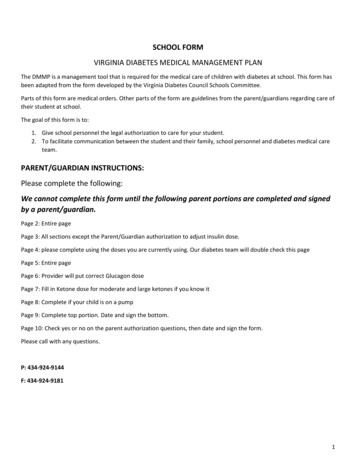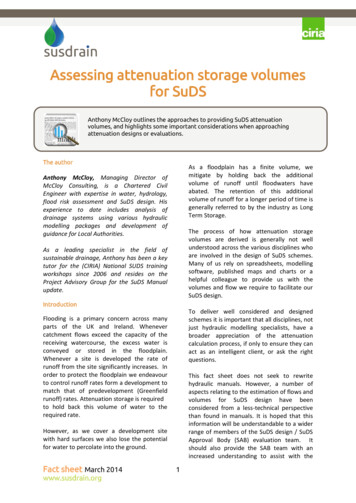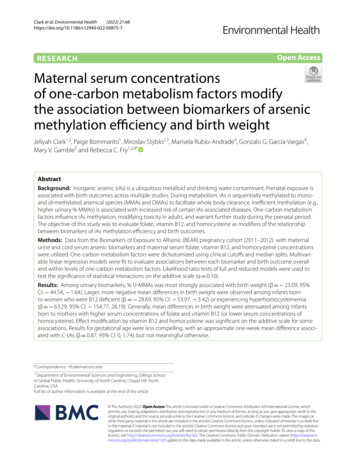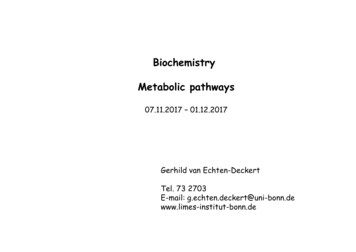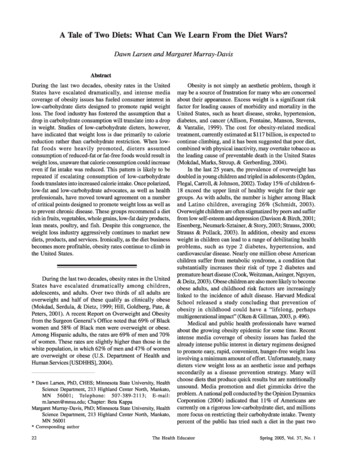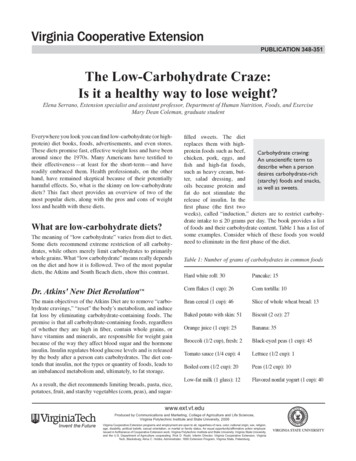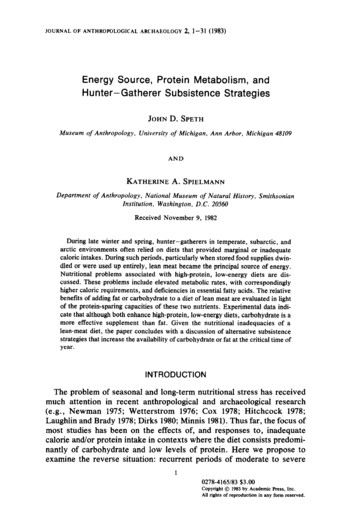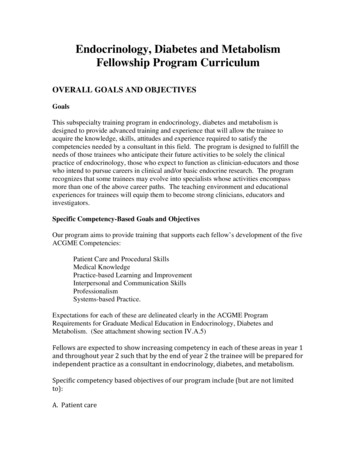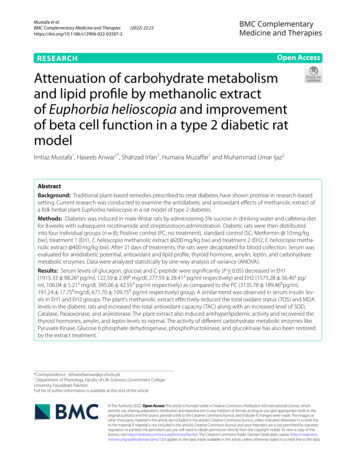
Transcription
Mustafa et al.BMC Complementary Medicine and 2(2022) 22:23BMC ComplementaryMedicine and TherapiesOpen AccessRESEARCHAttenuation of carbohydrate metabolismand lipid profile by methanolic extractof Euphorbia helioscopia and improvementof beta cell function in a type 2 diabetic ratmodelImtiaz Mustafa1, Haseeb Anwar1*, Shahzad Irfan1, Humaira Muzaffar1 and Muhammad Umar Ijaz2AbstractBackground: Traditional plant-based remedies prescribed to treat diabetes have shown promise in research-basedsetting. Current research was conducted to examine the antidiabetic and antioxidant effects of methanolic extract ofa folk herbal plant Euphorbia helioscopia in a rat model of type 2 diabetes.Methods: Diabetes was induced in male Wistar rats by administering 5% sucrose in drinking water and cafeteria dietfor 8 weeks with subsequent nicotinamide and streptozotocin administration. Diabetic rats were then distributedinto four individual groups (n 8); Positive control (PC; no treatment), standard control (SC; Metformin @ 10 mg/kgbw), treatment 1 (EH1, E. helioscopia methanolic extract @200 mg/kg bw) and treatment 2 (EH2, E. helioscopia methanolic extract @400 mg/kg bw). After 21 days of treatments, the rats were decapitated for blood collection. Serum wasevaluated for antidiabetic potential, antioxidant and lipid profile, thyroid hormone, amylin, leptin, and carbohydratemetabolic enzymes. Data were analyzed statistically by one-way analysis of variance (ANOVA).Results: Serum levels of glucagon, glucose and C-peptide were significantly (P 0.05) decreased in EH1(1915.33 98.26a pg/ml, 122.59 2.99a mg/dl, 277.59 28.41a pg/ml respectively) and EH2 (1575.28 56.46a pg/ml, 106.04 5.21a mg/dl, 395.06 42.55a pg/ml respectively) as compared to the PC (3135.78 189.46bpg/ml,191.24 17.75bmg/dl, 671.70 109.75b pg/ml respectively) group. A similar trend was observed in serum insulin levels in EH1 and EH2 groups. The plant’s methanolic extract effectively reduced the total oxidant status (TOS) and MDAlevels in the diabetic rats and increased the total antioxidant capacity (TAC) along with an increased level of SOD,Catalase, Paraoxonase, and arylesterase. The plant extract also induced antihyperlipidemic activity and recovered thethyroid hormones, amylin, and leptin levels to normal. The activity of different carbohydrate metabolic enzymes likePyruvate Kinase, Glucose 6 phosphate dehydrogenase, phosphofructokinase, and glucokinase has also been restoredby the extract treatment.*Correspondence: drhaseebanwar@gcuf.edu.pk1Department of Physiology, Faculty of Life Sciences, Government CollegeUniversity, Faisalabad, PakistanFull list of author information is available at the end of the article The Author(s) 2022. Open Access This article is licensed under a Creative Commons Attribution 4.0 International License, whichpermits use, sharing, adaptation, distribution and reproduction in any medium or format, as long as you give appropriate credit to theoriginal author(s) and the source, provide a link to the Creative Commons licence, and indicate if changes were made. The images orother third party material in this article are included in the article’s Creative Commons licence, unless indicated otherwise in a credit lineto the material. If material is not included in the article’s Creative Commons licence and your intended use is not permitted by statutoryregulation or exceeds the permitted use, you will need to obtain permission directly from the copyright holder. To view a copy of thislicence, visit http:// creat iveco mmons. org/ licen ses/ by/4. 0/. The Creative Commons Public Domain Dedication waiver (http:// creat iveco mmons. org/ publi cdoma in/ zero/1. 0/) applies to the data made available in this article, unless otherwise stated in a credit line to the data.
Mustafa et al. BMC Complementary Medicine and Therapies(2022) 22:23Page 2 of 12Conclusion: Current study indicates the antioxidant and antidiabetic potential of E. helioscopia methanolic extractin normalizing the lipid profile, thyroid hormones, amylin, leptin, and carbohydrate metabolism in type 2 diabetic ratmodel.Keywords: Euphorbia helioscopia, Antioxidant, Methanolic extract, Antidiabetic, Carbohydrate metabolismBackgroundDiabetes mellitus, one of the most common metabolicconditions causing hyperglycemia due to disruption inthe metabolism of carbohydrates, proteins, and lipidsinduced by a relative or absolute decline in insulin secretion and insulin action [1]. The incidence of diabetesin modern society is growing gradually and becomingan epidemic. There are currently 415 million diabeticpatients globally and by 2040 it is estimated to be around642 million [2]. Pakistan has 27.4 million diabetic patientsof age 20 years estimated by the second national diabetes survey of Pakistan (NDSP-II 2016–17) at 26.3% of diabetes prevalence [3, 4].The World Health Organization (WHO) reports thatabout three-quarters of the population, primarily in LatinAmerican, African and Asian countries, relies on herbalpreparations in their conventional primary health caremedicine system [5]. Pakistan has large biodiversity ofgenetic plants and, owing to inadequate access to healthassistance, medicinal plants have been widely used byalmost all populations [6].Natural products continue to represent the main sourceof therapeutic and preventive regimens of different illnesses. The family of Euphorbiaceae contains a varietyof medicinal plants possessing a wide range of differentreported therapeutic effects. Euphorbia helioscopia isan annual herbaceous medicinal plant belonging to thespurge family Euphorbiaceae. It contains 24 secondarymetabolites, including euphornin, euphoheliosnoid D,euphornin (B, C), euphoscopin (A-C, F, J), epieuphorscopin (A, B), hemistepsin, helioscopinolide (B, C), 2 alphahydroxy helioscopinolide B, 4 5-dihydroblumentol A,guaiane lactone, icariside aglycone B2, 2′ 4′ 4′-trihdroxychalcone, echinatialicochalcone (A, B), galabrone and4′ 5 7-trihdroxyflavanone [7]. These secondary metabolites induce numerous pharmacological effects includingvasodepressor activity, anti-inflammatory, antimicrobial activity, antioxidant, anti-tumor, and wound healingactivities [8–12]. Traditionally, the plant has been usedto treat a variety of pathological disorders, including skindiseases, warts, bowel parasites, migraines, and gonorrhea [13]. The medicinal plants having antioxidant andanti-inflammatory activities can reduce hyperglycemia[14]. We previously reported the in vitro antioxidant andantidiabetic activities of E. helioscopia extracts in whichthe methanolic extract showed maximum antidiabeticand antioxidant activity as compared to ethanolic andaqueous extracts of the plant [15]. So the present studywas conducted to examine the ability of methanolicextract of E. helioscopia to modulate oxidative stress,hyperglycemia, and carbohydrate metabolism in a type 2diabetic rat model.MethodsProcurement of plantThe plant Euphorbia helioscopia was locally collectedfrom the premises of Government College University,Faisalabad, Pakistan, from October 15, 2020, to October30, 2020. The plant was identified by the expert Botanist(Dr. Qasim Ali) from the Department of Botany, Government College University Faisalabad, Pakistan, with aspecimen voucher number, 247-bot-2020.Extract preparationAfter washing with distilled water, the plant was shadedried and grounded into a fine powder form. Two hundreds and fifty grams of this powder was soaked for 72 hin 1250 ml of methanol with periodic stirring and mixing.The solution was subsequently filtered through Whatman filter paper. The process was repeated thrice, andthe final filtrates were concentrated in a rotary evaporator at 40 C and finally transferred into labeled petridishes. The petri dishes were kept in an incubator at 40 Cuntil dried properly. The yield of the extract was 15.7% ofthe dry weight of the plant powder. Thereafter the extractwas stored at 4 C until further use.Experimental animals and induction of diabetesAfter the approval from Animal Care and Ethical Committee, Government College University Faisalabad(GCUF/ERC/2223), 48 male albino (Wistar strain) ratsof age 2 1 week, weighing 60 10 g were procuredfrom the animal experimental station of Department ofPhysiology, Government College University, Faisalabad,Pakistan. The rats were kept in wired cages with ad libitum approach to cafeteria diet and 5% sucrose in drinking water at standard conditions (temp 26 C 2 C;light 12 h light and dark cycle; ambient humidity 40–60%). Another group of eight rats as negativecontrol (n 8; NC) were kept in the same conditionsexcept for 5% sucrose in drinking water and cafeteriadiet, during the complete duration of the experimental
Mustafa et al. BMC Complementary Medicine and Therapies(2022) 22:23trial. The cafeteria diet contained cheese, peanuts, various biscuits, potato chips, corn chips, crackers, pizza, andvarious chocolates, along with a control chow diet. Anyfive of these cafeteria diets were given to the rats daily insurplus amounts. The foods ration was changed daily tosustain the diversity by substituting three foods with newfood items. So that the rats did not get the same diets formore than two successive days at one time [16]. The cafeteria diet and 5% sucrose in drinking water were givento the rats starting from the age of 2 1 weeks for 56 days(8 weeks). After 8 weeks the rats weighing 300 20 g,with blood glucose level 150 mg/dl were fasted overnight and administered nicotinamide (NIC; 110 mg/kgbw; ip) in normal saline [17]. After 15 min of the administration of nicotinamide, the dose of freshly preparedstreptozotocin (STZ; 65 mg/kg bw; ip) in cold citratebuffer (0.1 M, pH 4.5) was administered [17]. Hyperglycemia was confirmed after 72 h by measuring blood glucoselevels using a glucometer (Glucocard 01-mini, ArkrayFactory Inc., Japan) [17]. The 32 rats with blood glucose level 250 mg/dl were divided equally into the following 4 groups PC (Positive control; no treatment), SC(Standard control group; Treated with metformin 10 mg/kg bw [18] via oral lavage), EH1 (Treatment group-I fedon CMD and plant extract dose 200 mg/Kg BW via orallavage), EH2 (Treatment group-II fed on CMD and plantextract dose 400 mg/Kg BW via oral lavage). The dosesof the plant extract were followed by previous studies[19–21] on the antidiabetic potential of the methanolicextract of plants from the euphorbeacea family. Suspensions of metformin in normal saline and plant extractsin distilled water were made on daily basis. Volumes ofthese suspensions were calculated according to the bodyweight of each rat in the relevant group. The calculatedvolume of the suspension was delivered to the rats viaoral lavage using an intragastric tube. No motility or toxiceffects were observed in any experimental group. Afterthe completion of 21 days of treatment, the rats were sacrificed by cervical decapitation under ether anesthesia forthe collection of blood directly from the jugular vein invacutainers without anticoagulant. Serum was isolatedat 2000 g centrifugation for 10 min and kept at 20 C tillfurther analysis. Pancreas was excised and kept in 10%formalin for histopathology studies.Serum hormones levels and C‑peptideCommercially available ELISA kits manufactured byElabscience, USA were used to measure the serumlevels of various hormones like Triiodothyronine (fT3;ng/ml; Cat. No. E-EL-0079; Sensitivity: 0.937 pg/ml;Range of Detection: 1.6–100 pg/ml), Thyroxin (fT4; μg/dl; Cat. No. E-EL-0122; Sensitivity: 0.937 pg/ml; Rangeof Detection: 1.6–100 pg/ml), Thyroid StimulatingPage 3 of 12Hormone (TSH; ng/ml; Cat. No. E-EL-R0976; Sensitivity: 0.747 ng/ml; Range of Detection: 1.25–80 ng/mL),Insulin (Rat INS; ng/ml; Cat. No. E-EL-R2466; Sensitivity: 0.20 ng/ml; Range of Detection: 0.309–20 ng/ml;),C-peptide (Rat C-P; pg/ml; Cat No: E-EL-R3004; Sensitivity: 9.4 pg/mL; Range of Detection: 15.64-1000 pg/mL), Leptin (Rat LEP; ng/ml; Cat. No. E-EL-R0528;Sensitivity: 0.11 ng/ml; Range of Detection: 0.16–0.92 ng/ml), and Amylin (Rat IAPP; pg/ml; Cat. No.E-EL-R2448; Sensitivity: 37.51 pg/ml; Range of Detection: 62.51–4000 pg/ml). Coefficient of variation for allthe kits was 10%. The manuals provided in the kitswere followed for the assay procedure for all the abovementioned hormones and C-peptide.Carbohydrate metabolic enzymes and superoxidedismutaseSerum levels of Carbohydrate metabolic Enzymes,Pyruvate Kinase (Rat PK; ng/ml Cat. No. E-EL-R0837),Phosphofructokinase (Rat 6.PFK; ng/ml; Cat. No. E-ELR1214; Sensitivity: 0.957 ng/mL; Range of Detection:1.6–100 ng/ml), Glucose 6-Phosphate Dehydrogenase(Rat G6PD; μlU/ml; Cat. No. E-EL-R0428; Sensitivity: 0.11 ng/ml; Range of Detection: 0.16–11 ng/ml), andglucokinase (Rat GCK; ng/ml; Catalog No. E-EL-R0426Sensitivity: 0.39 ng/mL; Range of Detection: 0.63–41 ng/ml), and Superoxide dismutase (Rat SOD; Catalog No.E-EL-R1424; Sensitivity: 0.11 ng/ml; Range of Detection:0.16–11 ng/ml) were analyzed by using ELISA kits manufactured by Elabscience, USA. The coefficient of variationfor all the ELISA kits was 10%. The manuals providedin the ELISA kits were followed for the assay procedurefor all the above-mentioned carbohydrate metabolicenzymes and superoxide dismutase.Serum lipid profile and glucose levelCommercially available colorimetric assay kits manufactured by Sigma-Aldrich, Germany, were used forthe serum levels of Total Cholesterol (Catalog Number CS0005; mg/dl; Detection range: 1–5 μg), Triglycerides (Catalog Number MAK266; mg/dl; Sensitivity: 2pmole–10 nmole; Detection range: 2–10,000 μM range),HDL-Cholesterol (Catalog Number MAK045; mg/dl;Detection range: 1–5 μg). The manuals provided in thekits were followed for the assay procedure of serum totalcholesterol, serum triglycerides, and serum HDL-cholesterol level determination. Serum LDL-Cholesterol wascalculated by using the Friedrick equation. Serum glucose was quantified through Bioclin Glucose Monoreagent diagnostic kit having detection range of 2-500 mg/dlwith CV% 3.11.
Mustafa et al. BMC Complementary Medicine and Therapies(2022) 22:23Total antioxidant capacity (mmol Troloxequiv./L)The method for evaluating total antioxidant capacity(TAC) in serum samples was previously defined by Nisaret al. [22]. In short, the antioxidants present in the samplebleach the ortho dianisidine color in the assay reagent.Increased antioxidant levels in the sample contribute tohigher bleaching and reduced absorbance, suggesting aninverse standard curve. The Biolab 310 semi-auto analyzer was used with biochromatic wavelength modification (660 and 870 nm) by calibrating Trolox standardsat 1, 3, 5, and 7 mmol/L concentrations. This assay hada minimum observable value of 0.19 mmol/7 and linearity of up to 8 mmol Troloxequivalent/l, with a coefficient ofvariance 3% in the intra-assay.Total oxidant status (TOS; μmol H2O2 equiv./L)The serum TOS was measured by using the techniquepreviously adopted by Nisar et al. [22]. The standardcurve was constructed from different hydrogen peroxide (H2O2) concentrations and the TOS was represented asμmol H2O2 equivalent/l. The assay’s detection range was 3% and the CV of the Intra assay was held 10% andlinearity was up to 250 μMol of H2O2 equivalent /l [22].Paraoxonase (PON1) activity (U/L)For the estimation of PON1 activity, the methoddefined by Anwar et al. [23] was used. Using the reference formula, the activity of the enzyme was measuredand stated in Unit/min/l. Intra assay CV was 10% andthe paraoxon hydrolysis rate was constant for up to6 min. The minimum measurable activity was between80 and 100 U/min/L for this assay.Arylesterase activity (KU/L)By adopting the protocol as previously adopted byAnwar et al. [23], the activity of arylesterase was evaluated using the given equation in the reference procedure. The CV was 7% and the initial hydrolysis ratewas stable for up to 5 min.Serum malondialdehyde level (pM/dl)The serum level of malondialdehyde (MDA) was calculated by the thiobarbituric reactive substance assay(TBARS) reported by Al-Assaff and Takruri [24], whichis based on the pink pigment-producing MDA reaction with thiobarbituric acid (TBA). For this, 500 μlof the serum was mixed with 2.5 ml of 10% TBA solution, then the tube was put for 15 min in a boiling waterbath. It was then cooled in cold water and centrifugedfor 5 min at 3000 g. In a test tube, 2 ml of the supernatant was applied to 1 ml of 0.67% TBA solution and putfor another 15 min in a boiling water bath, and finallyPage 4 of 12cooled in tap water. The absorbance was measured at532 nm using Biolab 310, Biolab Scientific Ltd. Canadaagainst distilled water as a blank [24, 25].Catalase activity assay (KU/min)Catalase enzyme activity was measured by mixing the100 μl of serum sample in 1000 μl substrate (649 mmol/ml H2O2 in 59 mmol/l phosphate buffer saline, pH 7.4). Inthe control test tube, the substrate was replaced with 1 mldistilled water and in the standard tube, the serum wasreplaced with 100 μl of distilled water. After 3 min of incubation at 37 C, the reaction was terminated with ammonium molybdate (32.4 mM). The optical density of theyellow-colored complex produced from molybdate and H2O2 was calculated at 374 nm against the blank using Biolab 310, Biolab Scientific Ltd. Canada. The equation of firstorder reaction (k) was used to measure catalase enzymeactivity:S Vt2.303 log kU tS MVsS : optical density of standard; S: optical density of testsample; M: optical density of control sample; Vt: overallvolume of all components in the test tube; V s: total volumeof serum sample [26].Histopathology of pancreasPancreas tissues were taken out from the 10% formalin andembedded in paraffin to make the blocks. Sections of 4 to5 μ were sliced with Microtome [Bk-Mt268m; Biobase Biodustry (Shandong) Co., Ltd.] for histopathological examination. The tissue sections were placed on a glass slide coatedwith albumin. It was then deparaffinized, rehydrated, andfinally stained with hematoxylin and eosin stain. The stainedslides were then examined under a light microscope afterDPX mounting and covered with a coverslip [27].Statistical analysisThe SPSS software version 23 was used for statisticalanalysis. All datasets were statistically demonstrated asmean standard error. One-way Analysis of Variance(ANOVA) was used to find the significance of differenceamong various groups followed by turkey’s post hoc test.The level of significance was actively considered at p 0.05with 8 number of samples in each group (n 8).ResultsAntioxidant activityEffect of Euphorbia helioscopia on oxidative stressThe mean serum TAC level was increased significantly(P 0.05) in the EH2 group (2.5 0.47b mM/l) as compared with other experiment groups (Table 1). There
Mustafa et al. BMC Complementary Medicine and Therapies(2022) 22:23Page 5 of 12Table 1 Effect of Euphorbia helioscopia on oxidative stress markersGroupsPON1 (U/L)p 0.005NC18.60 3.62aPCSCEH1EH 2ARY (KU/L)p 0.00617.18 0.98a26.24 2.57ab24.59 0.53ab31.28 3.58b140.88 5.5aba125.71 1.78ab147.18 6.83ab145.29 6.31b163.41 7.77TAC (mM/L)p 0.036TOS (uM/L)p 0.0011.17 0.2abaab1.04 0.411.4 0.17ab1.61 0.2b2.5 0.47MDA (pM/dl)p 0.02Catalase (KU/min)p 0.0SOD (ng/ml)p 0.04122.56 4.72ab1.66 0.34ab16.93 2.06ab7.83 0.16abababb31.13 3.3423.26 1.97bc2.64 0.47a1.06 0.21aa18.94 0.8212.97 0.61bc1.17 0.280.82 0.5a10.07 0.71b17.56 0.68b19.37 4.29c31.18 1.785.17 0.8a6.52 0.89ab7.87 0.15ab8.39 1.06bData are expressed as means standard errors of a total of 8 samples for each group. Values with different letters in a column are significantly different (P 0.05). NC,negative control group; PC, positive control group (Diabetic rats without any treatment); SC (Standard control group (Diabetic rats treated with metformin at 1 mg/kg body weight via oral lavage); EH1, Treatment group-I (Diabetic rats given methanolic extract of Euphorbia helioscopia at dose of 200 mg/Kg BW via oral lavage);EH2, Treatment group-II (Diabetic rats given methanolic extract of Euphorbia helioscopia at dose of 400 mg/Kg BW via oral lavage); PON1, Paraoxonase activity; ARY,Arylesterase activity, TAC; Total antioxidant capacity, TOS; Total oxidant status, SOD; Superoxide dismutasewas also a non-significant increase in TAC value in EH1(1.61 0.2ab mM/l) and SC group (1.4 0.17ab mM/l)compared with the PC group (1.04 0.41a mM/l). Thedifference between EH1 and EH2 was non-significant.Euphorbia helioscopia extract significantly (P 0.05)decreased the TOS in the EH1 (18.94 0.82a uM/l) andEH2 groups (12.97 0.61a uM/l) (Table 1) as comparedwith the PC (31.13 3.34b uM/l) group but the difference between the mean TOS value of EH1 and EH2 wasnot significant. The mean TOS value in the SC groupwas also decreased as compared with the PC group butthe change was not significant. Euphorbia helioscopiamethanolic extract significantly (P 0.05) increased theantioxidant enzyme SOD concentration in serum at thehigher dose of 400 mg/kg in the EH2 group (8.39 1.06bng/ml) as compared to the PC group (5.17 0.8a ng/ml)but the increase in the Mean SOD value in SC and EH1group was not significant as compared with the PC group(Table 1). A dose-dependent increase in serum catalaseactivity in the EH1 (19.37 4.29b KU/min) and EH2groups (31.18 1.78c KU/min) as compared to the PCgroup (10.07 0.71a KU/min) was observed. There wasalso a significant increase in the catalase activity of serumcatalase activity of the SC group (17.56 0.68b KU/min)as compared with the PC group (10.07 0.71a KU/min).Statistically significant (P 0.05) decrease was observedin MDA levels in the EH2 group (0.82 0.5a pM/dl)group as compared to the PC group (2.64 0.47bc pM/dl).The lower dose of the plant non significantly decreasedthe serum MDA levels in the EH1 group (1.17 0.28bcpM/dl) and SC group (1.06 0.21ab pM/l) as compared tothe PC group (2.64 0.47bc pM/dl). There was a significantly (P 0.05) increase in the serum arylesterase andparaoxonase activities in the EH2 group (163.41 7.77bKU/l and 31.28 3.58b U/l respectively) as comparedto the PC group (125.71 1.78a KU/l and 17.18 0.98aU/l respectively). Activities of these enzymes were alsoincreased in the EH1, and SC groups, but the change wasnon-significant as compared with the PC group (Table 1).Antidiabetic activityEffect of Euphorbia helioscopia on insulin, glucagon, glucose,and C‑peptideThe serum level of insulin was decreased significantly(P 0.05) in the EH1 (13.08 0.95a ng/ml) groupas compared to the PC (22.42 3.03b ng/ml) group.Decrease in serum insulin level was also observed inEH2 (15.16 1.27ab ng/ml), SC (17.23 1.65ab ng/ml), and NC groups (17.26 1.84ab ng/ml) as compared to the PC (22.42 3.03b ng/ml) group (Fig. 1: A)but the change was statistically non-significant. Themean serum levels of glucagon, glucose and C-peptidewere significantly (P 0.05) increased in PC group(3135.78 189.46b pg/ml, 191.24 17.75b mg/dl,671.70 109.75b pg/ml respectively) as compared to NCgroup (1928.58 339.85a pg/ml, 137.20 16.49a mg/dl,372.85 20.46a pg/ml respectively) (Fig. 1: B, C, D). Allthese parameters were decreased significantly (P 0.05)in the EH1, EH2, and SC groups as compared to the PCgroup (Fig. 1: A, B, C, D).Effect of Euphorbia helioscopia on carbohydrate metabolicenzymesPyruvate Kinase, Glucose 6 phosphate dehydrogenase,phosphofructokinase, and glucokinase levels in serumwere increased in the EH2 group (35.91 6.19b ng/ml,8.12 1.39b ng/ml, 70.44 4.4b ng/ml, 9.1 0.71b ng/mlrespectively) as compared to the PC group (13.69 2.48ang/ml, 1.57 1.43a ng/ml, 23.29 10.23a ng/ml, 2.52 1ang/ml respectively; Fig. 2: A, B, C, D). However, a significant difference was not seen in the serum levels of theseenzymes in the EH1 group as compared to NC and SCgroups.
Mustafa et al. BMC Complementary Medicine and Therapies(2022) 22:23Page 6 of 12Fig. 1 Effect of Euphorbia helioscopia on insulin, glucagon, glucose and C-peptide. Data are expressed as means standard errors of a total of8 samples for each group. Bars with different letters are significantly different (P 0.05). NC, negative control group; PC, positive control group(Diabetic rats without any treatment); SC (Standard control group (Diabetic rats treated with metformin at 1 mg/kg body weight via oral lavage);EH1, Treatment group-I (Diabetic rats given methanolic extract of Euphorbia helioscopia at dose of 200 mg/Kg BW via oral lavage); EH2, Treatmentgroup-II (Diabetic rats given methanolic extract of Euphorbia helioscopia at dose of 400 mg/Kg BW via oral lavage)Fig. 2 Effect of Euphorbia helioscopia on carbohydrate enzymes. Data are expressed as means standard errors of a total of 8 samples for eachgroup. Bars with different lowercase letters are significantly different (P 0.05). NC, negative control group; PC, positive control group (Diabetic ratswithout any treatment); SC (Standard control group (Diabetic rats treated with metformin at 1 mg/kg body weight via oral lavage); EH1, Treatmentgroup-I (Diabetic rats given methanolic extract of Euphorbia helioscopia at dose of 200 mg/Kg BW via oral lavage); EH2, Treatment group-II (Diabeticrats given methanolic extract of Euphorbia helioscopia at dose of 400 mg/Kg BW via oral lavage
Mustafa et al. BMC Complementary Medicine and Therapies(2022) 22:23Effect of Euphorbia helioscopia on amylin and leptinSerum levels of amylin and leptin were significantly(P 0.05) decreased in the EH2 (2317.53 63.15bng/ml and 0.67 0.06a ng/ml respectively), andSC (2075.1 40.67ab ng/ml and 1.425 0.19ab ng/ml respectively) groups in comparison to PC group(2962.45 213.81a ng/ml and 1.81 .39b ng/ml respectively) but there was a non-significant decrease in theserum leptin levels in EH1 group when compared to thePC group. However, the decrease in serum amylin levelof EH1 was significant as compared to the PC group(Table 2). The difference of both amylin and leptin in EH1was non-significant from the EH2 group.Effect of Euphorbia helioscopia on thyroid hormonesMean values of T3 and T4 were significantly (P 0.05)increased in the EH2 group (77.35 4.59b pg/ml and73.67 14.11b ng/ml respectively) as compared to thePC group (40.66 6.42a pg/ml and 18.94 3.08a ng/mlrespectively). Statistically, a non-significant increase inT3 and T4 levels was also observed in the EH1 groupcompared to the PC group. Serum TSH level was alsoincreased in the EH1 and EH2 groups as compared tothe PC group in a dose-dependent manner. However, thisincrease in TSH was statistically non-significant. Supplementation of metformin also increased significantly(P 0.05) the serum TSH in the SC group as compared tothe PC group (Table 2).Effect of Euphorbia helioscopia on lipid profileTotal cholesterol, LDL and triglyceride levels were significantly (P 0.05) decreased in EH2 group (143.27 1.39amg/dl, 172.21 12.41a mg/dl, 12.46 12.50a mg/dlrespectively) as compared to PC group (271.04 27.39bmg/dl, 288.17 40.06b mg/dl, 152.70 49.86b respectively) (Fig. 3: A, B, D). Whereas serum HDL levels weresignificantly increased in the EH1 (120.44 2.41b mg/dl) and EH2 groups (131.10 2.79b mg/dl) as comparedPage 7 of 12to the PC group (81.27 9.78a mg/dl) and no significantchange was observed among NC, EH1, and EH2 groups(Fig. 3: C). There was no significant difference in all thelipid profile parameters of the SC group as compared tothe PC group.Effect of Euphorbia helioscopia on pancreas histopathologyTissue samples from the pancreas were collected fromWistar rats of each experimental group to analyze histopathological changes in pancreatic tissue. Photomicrographs showing histological changes in rat pancreas of allgroups are presented in Fig. 4. As shown in Fig. 4. NC, thepancreas of rats in the negative control group had fullyactive islets of Langerhans with normal pancreatic betacells marked with blue-colored arrows. However, in thePC group (diabetic rats), the pancreas showed destruction of β-cells, small-sized islets of Langerhans, and lossof cellular contents as shown in Fig. 4. PC. In the diabetic rats treated with MthEh at both doses, as shown inFig. 4. EH1 and Fig. 4. EH2, there was a dose-dependentrestoration of the normal histological structure showingnormal pancreatic parenchyma with fully active β-cells inislets of Langerhans.DiscussionThe present study was conducted to examine the potential of Euphorbia helioscopia (a medicinal plant) as anantioxidant and antidiabetic agent in a type 2 diabetic ratmodel. The impact of the Euphorbia helioscopia treatment on carbohydrate metabolism and thyroid gland wasalso evaluated. The antidiabetic and antioxidant effectsof Euphorbiaceae family have been described previouslyin different animal models [28]. The rise in insulin andC-peptide levels in the untreated diabetic rats of the PCgroup is in contrast to type 2 diabetic animals, whereelevated blood glucose is followed by increased insulinsynthesis and insulin resistance resulting in hyperglycemia [29]. In humans with type 2 diabetes, the glucoseTable 2 Effect of Euphorbia helioscopia on Amylin, Leptin and Thyroid hormonesGroupsAmylin (pg/ml)p 0.007NC1736.35 75.97aPCSCEH1EH2c2962.45 213.81ab2075.1 40.67ab2078.19 55.38b2317.53 63.15Leptin (ng/ml)p 0.039T3 (pg/ml)p 0.0191.06 0.32ab48.44 0.47abb1.81 .39ab1.425 0.19ab1.12 0.05a0.67 0.06T4 (ng/ml)p 0.018a40.66 6.42ab54.97 10.19ab70.35 5.52b77.35 4.59TSH (ng/ml)P 0.0359.97 13.13aba18.94 3.08b74.55 14.94ab67.27 9.38b73.67 14.1184.90 21.38ab51.42 28.63a125.24 11.71b117.03 4.17ab123.09 8.97abData are expressed as means standard errors of a total of 8 samples for each group. Values having different lowercase letters in
diet, during the complete duration of the experimental Conclusion: Current study indicates the antioxidant and antidiabetic potential of E. helioscopia methanolic extract in normalizing the lipid prole, thyroid hormones, amylin, leptin, and carbohydrate metabolism in type 2 diabetic rat model.
